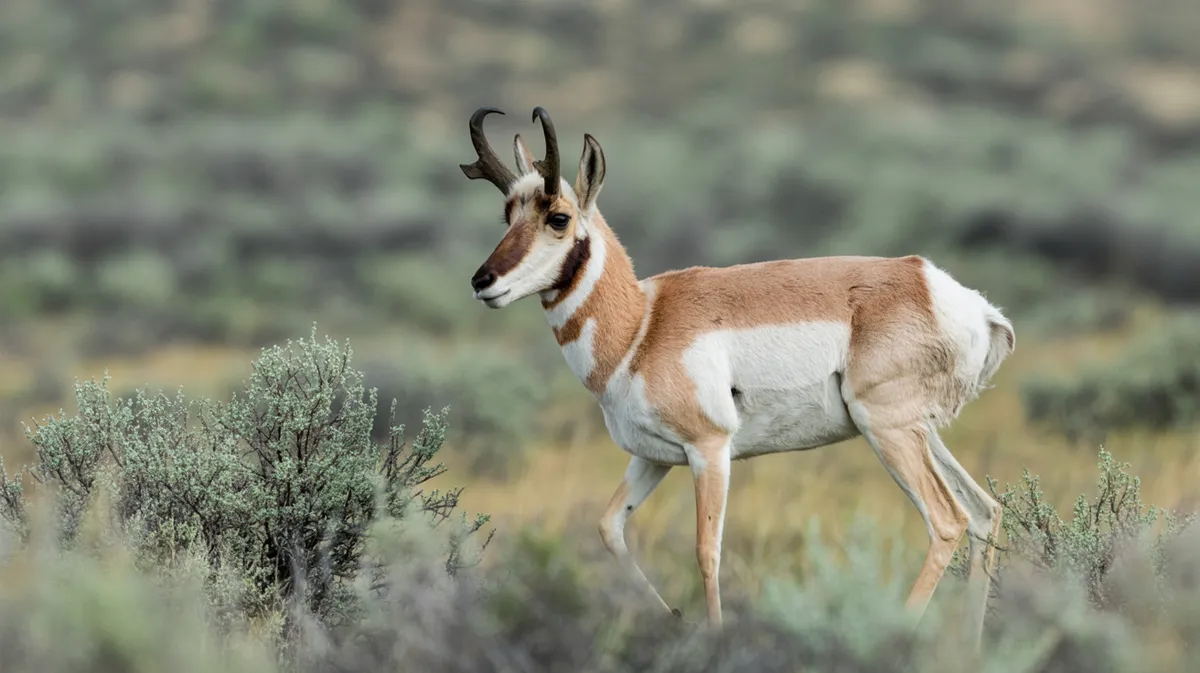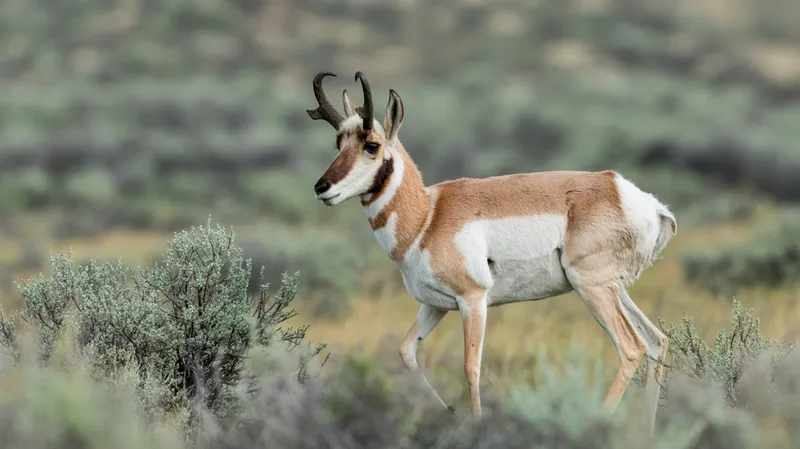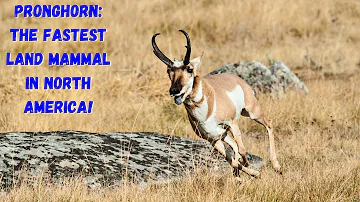
Pronghorn
Antilocapra americana

Meet the Pronghorn
The pronghorn is a unique hoofed mammal native to North America, renowned for its incredible speed and endurance. With a tan to reddish-brown coat, white underparts, and distinctive white rump patches, pronghorns are easily recognized on open grasslands and sagebrush plains. Unlike true antelopes, pronghorns are the only surviving member of their family, Antilocapridae. Their large eyes provide excellent vision, and both males and females have horns, though those of the females are much smaller.
Classification
Mammal
Habitat
Open grasslands, sagebrush plains, and deserts
Diet
Herbivore
Lifespan
7-10 years in the wild
Conservation
Least Concern
Weight
35-70 kg (77-154 lbs)
📖Fascinating Facts
Super Sprinter
Pronghorns can maintain high speeds for longer distances than any other North American mammal, making them exceptional endurance runners.
Eagle Eyes
Pronghorns have extremely large eyes, giving them a wide field of vision to spot predators from afar.
Unique Horns
Unlike true antelopes, pronghorns have branched horns with a prong and shed the outer sheath annually, a trait not seen in any other horned mammal.
📋Detailed Description
The pronghorn (Antilocapra americana) is a medium-sized ungulate, standing 81–104 cm (32–41 in) at the shoulder and weighing between 35–70 kg (77–154 lbs), with males typically larger than females. Its body is built for speed, with long, slender legs, a lightweight frame, and a large windpipe and heart to support rapid oxygen intake. The pronghorn's coat is composed of hollow hairs that provide insulation against both heat and cold, and its coloration—tan to reddish-brown with white underparts, throat patches, and rump—offers camouflage in open habitats. Both sexes possess horns: males' horns are 25–43 cm (10–17 in) long, with a distinctive prong, while females' horns are much shorter and often lack a prong. Pronghorns have exceptionally large eyes, giving them a field of vision approaching 320°, crucial for detecting predators on the open plains. Their hooves are two-toed and highly adapted for running. Pronghorns are renowned for their speed, capable of sustained sprints up to 88.5 km/h (55 mph) and endurance running over long distances. Socially, they form loose herds that vary seasonally, with larger aggregations in winter and smaller groups or solitary individuals in summer. Their digestive system is ruminant-like, enabling efficient extraction of nutrients from fibrous, low-quality forage typical of arid North American grasslands and shrublands.
💡 Did you know?
Pronghorns evolved their speed to outrun extinct North American cheetahs, not any current predator.
🔬Research & Sources
Wikipedia Summary
The pronghorn is a species of artiodactyl mammal indigenous to interior western and central North America. Though not an antelope, it is known colloquially in North America as the American antelope, prong buck, pronghorn antelope, and prairie antelope, because it closely resembles the antelopes of the Old World and fills a similar ecological niche due to parallel evolution. It is the only surviving member of the family Antilocapridae.
Last Modified: 6/2/2025
🎭Behavior & Social Structure
Pronghorns are diurnal, being most active during dawn and dusk (crepuscular), when they feed and travel. They are primarily grazers but will browse on forbs and shrubs, especially sagebrush, during winter. Pronghorns rely on keen eyesight and speed rather than hiding to evade predators, often forming alert groups that communicate danger through visual signals, such as raising the white rump patch. Social structure is fluid: females and young form nursery groups, while adult males may be solitary or form bachelor groups outside the breeding season. During the rut, dominant males establish and defend territories, herding females and engaging in ritualized displays and occasional combat. Pronghorns migrate seasonally in some regions, traveling up to 250 km (155 mi) between summer and winter ranges. They are known for their high alertness and can spot movement up to 6.5 km (4 mi) away.
👶Reproduction & Life Cycle
The breeding season, or rut, occurs from mid-September to early October. Males compete for access to females through displays and occasional fights, using their horns. Females typically give birth to twins after a gestation period of about 7.5–8 months (235 days), usually in late May or early June. Newborns are precocial, able to stand and run within hours, but remain hidden in vegetation for several days to avoid predation. Mothers nurse and tend to their young, which join nursery groups after a week. Sexual maturity is reached at 15–16 months, but most females breed for the first time at two years. Parental care is provided solely by the female; males do not participate in rearing offspring.
🛡️Adaptations & Survival
Pronghorns exhibit a suite of adaptations for life in open, arid environments. Their remarkable speed and stamina are evolutionary responses to now-extinct North American predators, such as the American cheetah (Miracinonyx). Their large lungs, heart, and trachea support high oxygen demands during running. The pronghorn's vision is among the sharpest of any North American mammal, with large eyes and a wide field of view. Their hollow hair provides insulation and aids thermoregulation. Pronghorns are highly water-efficient, obtaining most of their moisture from food, and can survive in areas with limited surface water. Their digestive system allows them to process tough, fibrous plants, and they can detoxify certain plant secondary compounds that are toxic to other herbivores.
📚Research Sources
🎨Cultural Significance
Pronghorns have long been significant to Indigenous peoples of the Great Plains and Southwest, featuring in hunting traditions, folklore, and as a food source. Their speed and endurance have made them symbols of agility and freedom in North American culture. In the 19th and early 20th centuries, pronghorns were heavily hunted for meat and hides, leading to dramatic population declines before conservation measures were implemented. Today, they are valued in wildlife watching, photography, and regulated hunting, contributing to local economies and conservation funding.
🔬Recent Research & Discoveries
Recent research has focused on pronghorn migration ecology, using GPS tracking to map ancient migration corridors and identify barriers. Studies on their vision have revealed adaptations for detecting predators at great distances. Genetic analyses have clarified subspecies relationships and informed conservation strategies for endangered populations. Ongoing research investigates the impacts of climate change on pronghorn habitat and the effectiveness of fence modifications in reducing mortality. The pronghorn's evolutionary history continues to be a subject of interest, particularly its unique placement as the sole surviving member of Antilocapridae.
🎥Wildlife Videos

The Remarkable Pronghorn Antelope Of North America | Wild America
Discover the incredible world of North America's unique Pronghorn Antelope Witness the remarkable evolution of these creatures, ...
Real Wild

Pronghorns: The Fastest Land Mammal in North America!
The pronghorn antelope is a marvel of nature, known for being the fastest land mammal in North America, capable of reaching ...
Wildlife Pedia English

Pronghorns: The American Sprinter Born To Race Cheetahs
The second fastest animal in the world is a North American Treasure. Get a print of the Pronghorn illustration in this episode: ...
Animalogic

The Pronghorn Antelope: Fastest Land Animal in the World! (4K)
In today's episode of The Wild Report, we'll learn about the pronghorn antelope, the fastest land mammal over distance in the ...
The Wild Report

Pronghorn Antelope - Wildlife documentary - North American Animals Migration - entertainment video
Documentary about pronghorn antelope. This is an interesting and informative video. thanks.
Saskman Vlogs

Pronghorn | animal documentary
Pronghorn | animal documentary The Pronghorn is one of the fastest and most resilient animals in America, and this animal ...
Cityanimal EN
🌍Habitat Information
The Pronghorn typically inhabits Open grasslands, sagebrush plains, and deserts environments. Pronghorns have adapted to their environments with specialized features and behaviors.
Primary Habitat:
Open grasslands, sagebrush plains, and deserts
More detailed habitat information will be available soon.
🛡️Conservation Status
The Pronghorn is currently classified as Least Concern. Conservation efforts are crucial for preserving this species for future generations.
Common Threats:
- 🏠Habitat loss and fragmentation
- 🌡️Climate change impacts
- 🎯Hunting and poaching
- 🏭Human-wildlife conflict
⚠️Threats & Conservation Challenges
While pronghorn populations are currently stable and classified as Least Concern by the IUCN, they face ongoing threats from habitat fragmentation due to agriculture, fencing, and urban development, which impede their historic migratory routes. Collisions with vehicles and barriers such as livestock fences are significant sources of mortality. Some populations, particularly the endangered Sonoran and Baja California subspecies, are threatened by overgrazing, drought, and illegal hunting. Climate change may exacerbate habitat loss and alter plant communities, impacting food availability. Conservation efforts focus on habitat protection, fence modification, and maintaining migration corridors.
🔬Scientific Classification
Scientific Name
Antilocapra americana
Classification Hierarchy
🔍 About Taxonomic Classification
Taxonomic classification is a hierarchical system used by scientists to classify and organize living organisms based on shared characteristics and evolutionary relationships.
The system moves from broad categories (Kingdom) to increasingly specific ones, with each animal's scientific name typically consisting of its Genus and species.
📝Community Notes
Share your observations and insights about the Pronghorn with our community of wildlife enthusiasts.
Join Our Community
Sign in to share your observations and connect with fellow wildlife enthusiasts.
Sign In to ContributeNo community notes yet
Be the first to share your observations about the Pronghorn!
Explore Pronghorn
Select a tab above to learn more about this amazing animal.
📸Photo Gallery
No photos available for this animal yet.
🌟Discover More Wildlife
Continue your journey of discovery with more fascinating animals from our database
